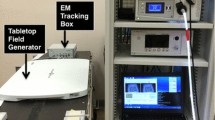Abstract
We propose an optical projection system aimed at improving laparoscopic surgery based on three-dimensional (3D) measurement that gives an effective information for robotic-assisted surgery and computer-aided surgery. Laparoscopic surgery, which involves the creation of small ports through the patient’s body for the laparoscope and surgical instruments, such as clamp, is minimally invasive and has generated a growing interest. There are techniques using the stereo laparoscope to obtain depth information. Active sensing when structured light is added to the laparoscope can reconstruct a 3D shape. However, active sensing that requires projection devices for the structured light leads to an increase in size. Large-sized projection and sensing systems affect surgical procedures. The size of the system is also larger than the size of port for the laparoscope. To remove the obstacle for the surgery, it is important to design downsized systems. For active sensing with the structured light, a small-size projection system is required to use a small port for the laparoscope. Therefore, we built the optical projection system toward downsizing the device to stereoscopic vision of the laparoscope using mirrors, and we show a new shape reconstruction method from its active sensing. Our Experimental results demonstrate the effectiveness of this proposed system and method.




Similar content being viewed by others
References
Stoyanov D, Darzi A, Yang GZ (2005) A practical approach towards accurate dense 3D depth recovery for robotic laparoscopic surgery. Comput Aided Surg 10(4):199–208
Jarvis RA (1983) A perspective on range finding techniques for computer vision. IEEE Trans Pattern Anal Mach Intell PAMI-5, 2:122–139
Besl PJ (1988) Active, optical range imaging sensors. Mach Vis Appl 1(2):127–152
Hayashibe M, Suzuki N, Nakamura Y (2006) Laser-scan endoscope system for intraoperative geometry acquisition and surgical robot safety management. Med Image Anal 10(4):509–519
Hasegawa K, Sato Y (2001) Endoscope system for high-speed 3D measurement. Syst Comput Jpn 32(8):30–39
Clancy NT, Stoyanov D, Maier-Hein L, Groch A, Yang G, Elson DS (2011) Spectrally encoded fiber-based structured lighting probe for intraoperative 3D imaging. Biomed Opt Express 2(11):3119–3128
Maurice X, Albitar C, Doignon C, De Mathelin M (2012) A structured light-based laparoscope with real-time organs’ surface reconstruction for minimally invasive surgery. In: Proceedings of the 2012 annual international conference of the IEEE engineering in medicine and biology society (EMBC), California, USA, August 28–September 1, 2012, pp 5769–5772
Lin J, Clancy NT, Stoyanov D, Elson DS (2015) Tissue surface reconstruction aided by local normal information using a self-calibrated endoscopic structured light system. MICCAI 2015. Lect Notes Comput Sci 9349:405–412
Lin J, Clancy NT, Elson DS (2015) An endoscopic structured light system using multispectral detection. Int J Comput Assist Radiol Surg 10(12):1941–1950
Salvi J, Pages J, Batlle J (2004) Pattern codification strategies in structured light systems. Pattern Recognit 37(4):827–849
Zhang S, Huang PS (2004) High-resolution, real-time 3-d shape acquisition. In: Proceedings of the 2004 IEEE computer society conference on computer vision and pattern recognition workshops (CVPR04), Washington DC, USA, June 27–July 2, 2004, 3, p 28
Chen T, Seidel HP, Lensch HPA (2008) Modulated phase-shifting for 3d scanning. In: Proceedings of the 2009 IEEE computer society conference on computer vision and pattern recognition workshops (CVPR08), Alaska, USA, June 23–28, 2008, pp1–8
Ghiglia DC, Romero LA (1996) Minimum L(p)-norm two-dimensional phase unwrapping. Opt Soc Am A 13(10):1999–2013
Zhang S, Li X, Yau ST (2007) Multilevel quality-guided phase unwrapping algorithm for real-time three-dimensional shape reconstruction. Appl Opt 46(1):50–57
Author information
Authors and Affiliations
Corresponding author
Additional information
This work was presented in part at the 21st International Symposium on Artificial Life and Robotics, Beppu, Oita Japan, January 20–22, 2016.
About this article
Cite this article
Sugawara, M., Kiyomitsu, K., Namae, T. et al. An optical projection system with mirrors for laparoscopy. Artif Life Robotics 22, 51–57 (2017). https://doi.org/10.1007/s10015-016-0311-8
Received:
Accepted:
Published:
Issue Date:
DOI: https://doi.org/10.1007/s10015-016-0311-8




